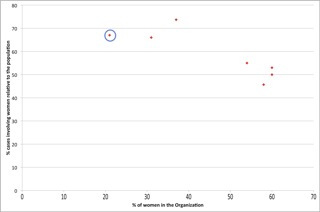Over the past two years, the Ombuds has seen double the number of cases involving women staff members compared to those involving men, relative to their populations. Two questions can thus be asked: is that a general phenomenon also seen in other organizations? Or is it related to the under-representation of women, namely is this a common situation in organizations with fewer women than men? If so, the Ombuds should notice different statistics in organizations where the number of women and men is comparable.
To answer these questions, several annual reports from international organizations have been analysed. The names of these organizations are kept confidential, as the reports are not public.
The results can be seen in this graph (right), limited solely by the number of Organizations for which such data is available. Note that if the number of women and men are almost equal (around 50-50%) then the number of cases coming to the Ombuds is quite equal in terms of gender. However, when women represent 20-25% of the staff, the number of cases involving women is double to the number of cases involving men.
Remember, a "case" can range from a simple discussion and advice, to interactions with other people and lengthy mediation. Not all cases are related to serious conflicts, but all these cases involve some difficulties in the workplace.
Conclusion:
How shall we interpret these results? It seems obvious that the more masculine the culture of an Organization, the more difficult it is for women. As a consequence, it is essential to follow the Code of Conduct which guarantees full impartiality towards genders. As the result for CERN demonstrates, everyone must make greaters efforts in the pursuit of the natural, respectful workplace.

